The Amish in Upstate New York and Surrounding States: A Look at Their Diverse Traditions and Values
The Amish are a traditional Christian group descended from the Anabaptist movement that originated in 16th century Europe. Numbering about 350,000 in North America, the Amish are known for simple living, plain dress, and a reluctance to adopt modern conveniences and technologies. While the Amish share core beliefs, they are not a unified group but rather a collection of autonomous church districts. These districts can vary significantly in their orthodoxy and acceptance of modern innovations.
Upstate New York is home to one of the largest Amish settlements in North America, centered around the towns of Clymer and Savona in Chautauqua County. Established in the 1950s, this settlement originally consisted of Amish migrants from Pennsylvania seeking affordable farmland. The population has since grown to over 15,000 Amish residents in over 100 church districts. This article will provide an overview of the Amish communities in upstate New York and surrounding states, exploring the diversity of traditions and conservatism across different districts.
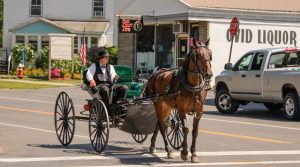
The Amish church districts in upstate New York fall under the umbrella of four affiliations: Swartzentruber, Andy Weaver, Old Order, and New Order. The Swartzentruber Amish are the most conservative group – they use no motorized farm equipment, outhouses instead of indoor bathrooms, and reject conveniences such as gas refrigerators and central heating. Swartzentruber men wear untrimmed beards and dark clothing with suspenders, while women wear long dresses and bonnets. Electricity, telephones, and automobiles are prohibited. The Swartzentruber districts are concentrated in the northern part of New York in St. Lawrence and Franklin Counties.
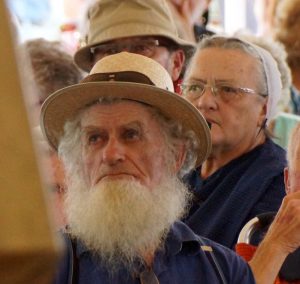
The Andy Weaver Amish are slightly more progressive, named after an Amish minister who broke from the Old Order in Pennsylvania in the 1950s over disagreements around technology usage. Andy Weaver Amish allow limited use of tractors for farming, as well as some shop tools and gas-powered washing machines. However, they still do not permit indoor plumbing, electricity, or telephones in the home. Andy Weaver districts are found throughout central New York.
The Old Order Amish make up the majority of districts in upstate New York. The Old Order accept most modern farm equipment including tractors, diesel generators to power equipment and lighting in barns, and pneumatic tools. While they do not permit electricity from public utility lines, some allow battery-powered conversions for lights or refrigeration. The Old Order vary in their use of certain technologies like solar panels or phones shared in a central shanty. Old Order women wear modest dresses but with patterned fabrics rather than solid colors. Old Order men often grow trimmed beards.
The most progressive Amish affiliation in New York is the New Order Amish. Originating in the 1960s, New Order Amish aim to maintain the Amish way of life while permitting certain technologies that keep families connected and farms prosperous. Most New Order Amish allow phones in the home, as well as electricity from diesel generators or solar panels. New Order dress remains plain. Though only a handful of districts, the New Order Amish tend to be concentrated in the more populated areas of western New York.
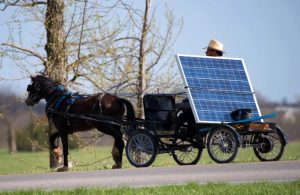
In addition to the New York settlements, Amish communities following the same range of affiliations are found in the neighboring states of Pennsylvania, Ohio, Vermont, and northern Indiana. The largest and most conservative population is located in the hills of central Pennsylvania, home to around 70,000 Amish in hundreds of Old Order and Swartzentruber districts. Most affiliations are represented among the Ohio Amish including sizable populations of Old Order and Andy Weaver adherents, though only a small Swartzentruber presence.
The more progressive New Order Amish have a relatively larger footprint in both Indiana and Vermont. Vermont is unique in having a high percentage of Amish farmers who tap maple trees for syrup, though the settlement remains small with under 2,000 total Amish residents. Overall, New York’s population ranks second only to Pennsylvania and Ohio in number of Amish inhabitants.
The reasons for such diversity in orthodoxy among the Amish are complex and steeped in centuries of history. The Amish identity emerged out of the Radical Reformation in Europe when early Anabaptists like Menno Simons broke from Catholicism over doctrinal differences, establishing tight-knit communities focused on adult baptism and pacifism. Amish settlers first came to Pennsylvania in the early 1700s to escape persecution in Europe, seeking religious freedom in the New World.
The first major Amish schism occurred in the 1860s when disagreements arose over whether excommunicated members could be shunned. The conservatives became known as Old Order Amish, rejecting social interaction with excommunicated persons. The more progressive faction became the Amish Mennonite church. Since then, other divisions have formed mainly over disagreements around technology usage, hence the range of orthodoxy seen even among Old Order districts today.
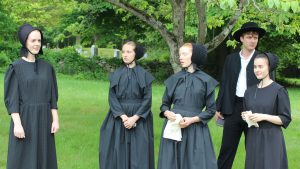
The diversity between Amish groups stems from two key facets of their tradition: gelassenheit and the Ordnung. Gelassenheit is the Amish philosophy of yielding to God, simplicity, and personal humility – setting aside pride and submission to the community. But gelassenheit does not mandate uniformity. Each district has an Ordnung, an oral set of rules that outlines standards for clothing, technology usage, and activities that are either required or prohibited. The Ordnung can vary considerably between districts and affiliations.
An example is farming technology. More progressive communities may permit tractors with steel wheels rather than rubber tires, as the rubber wheels are seen as enabling greater mobility which could lead families to stray farther from home. Yet even ultraconservative Swartzentruber Amish do allow some exceptions – diesel powered refrigerators are permitted because they help preserve food and support large families. The decisions around technology ultimately rest with the district and bishops. So diversity stems from localized interpretation of the gelassenheit and Ordnung.
Beyond technology, lifestyle varies between New York Amish in other aspects including education, career paths, and family life. Amish formal education ends at 8th grade, after which most Amish adolescents are expected to work and learn a trade. Some New Order communities allow high school attendance. Higher education is generally discouraged, though is permitted in rare instances – a small number of Amish youth have attended college to study medicine or nutrition to support their communities. After 8th grade Amish children are steeped in learning lifelong farming and homemaking skills.
Career opportunities generally align with traditional gender roles. Amish men often work in carpentry, farm-related occupations, and producing handcrafted goods. Amish women play an essential economic role in the home and tending to kitchen gardens and livestock. Women also run cottage industries selling baked goods or sewing items like quilts and clothing. Some Amish work in phone-related businesses like operating phone shanties to allow community access for emergencies and business purposes. The diversity of occupations depend on the district’s interpretation of appropriate integration with the non-Amish world.
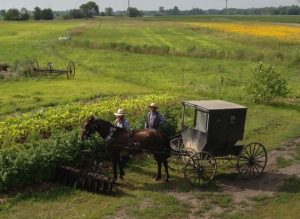
Family life is highly traditional among the Amish. Gender roles are clearly defined, with men as heads of household and women responsible for tending to domestic duties and raising children. Families are large, with an average of 6-8 children as Amish consider children both a blessing from God and an insurance policy, as some will leave the faith when grown. Only adults who have joined the church may marry, and church leaders heavily vet potential spouses. Divorce is extremely taboo. Amish families interact socially by hosting Sunday gatherings that rotate between households.
Courtship rituals are an important rite of passage for Amish youth. On designated evenings, groups of teens visit neighboring homes for socializing and matchmaking opportunities. Couples in courtship may talk and go on drives in the buggy together, granting rare freedom from oversight before settling into married life. But couples who marry too young may be censured by the district and temporarily excluded from the community. Amish youth are encouraged to experience Rumspringa – a period of greater social flexibility for teenagers who have not yet been baptized – before deciding whether to fully commit to the Amish church.
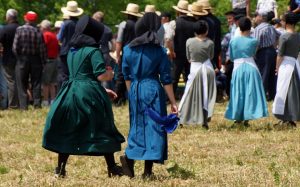
The diversity between Amish groups reflects disagreements rooted in their history, but also an adaptation of principles like gelassenheit and the Ordnung to fit modern times and support flourishing communities. Their population growth defies national trends towards smaller families and urbanization. Some argue communities have thrived because they temper, rather than outright reject, technological change – balancing tradition with pragmatic concession. Others posit that the Amish appeal simply lies in providing an alternative to modern values and close-knit community amidst a fragmented broader society.
Regardless, the Amish system has clearly provided a model enabling plain religious communities to maintain continuity and coherence despite external social change. Understanding Amish diversity helps underscore how minorities can sustain rich cultural and religious identities within a pluralistic modern nation, through adaptation around core values. It provides a microcosm for examining questions of assimilation versus preservation of tradition. The Amish will likely remain a distinct minority in the religious fabric of upstate New York and the nation. Yet their beliefs and way of life continue to captivate outsiders and inspire examination of how much to embrace change while holding onto faith and heritage.
In summary, this article has provided an overview of the Amish communities in upstate New York, northern Pennsylvania, Ohio, Indiana, and Vermont – analyzing the differences between Amish affiliations and districts in technology usage, lifestyle, family life, education, and career paths. Despite their shared religious roots dating back centuries, the Amish today are far from a homogeneous group. Through localized interpretation of key cultural tenants like gelassenheit and the Ordnung, the Amish have maintained religious identity while allowing flexibility between districts to govern change at their own pace. Understanding Amish diversity provides perspective on how minority sub-cultures evolve yet sustain tradition and community in a changing world.
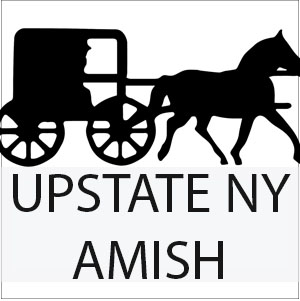


Leave a Reply
Want to join the discussion?Feel free to contribute!